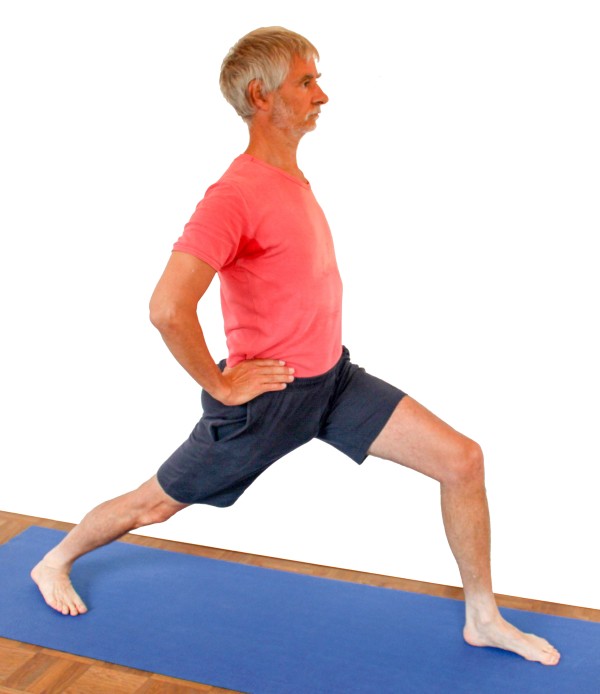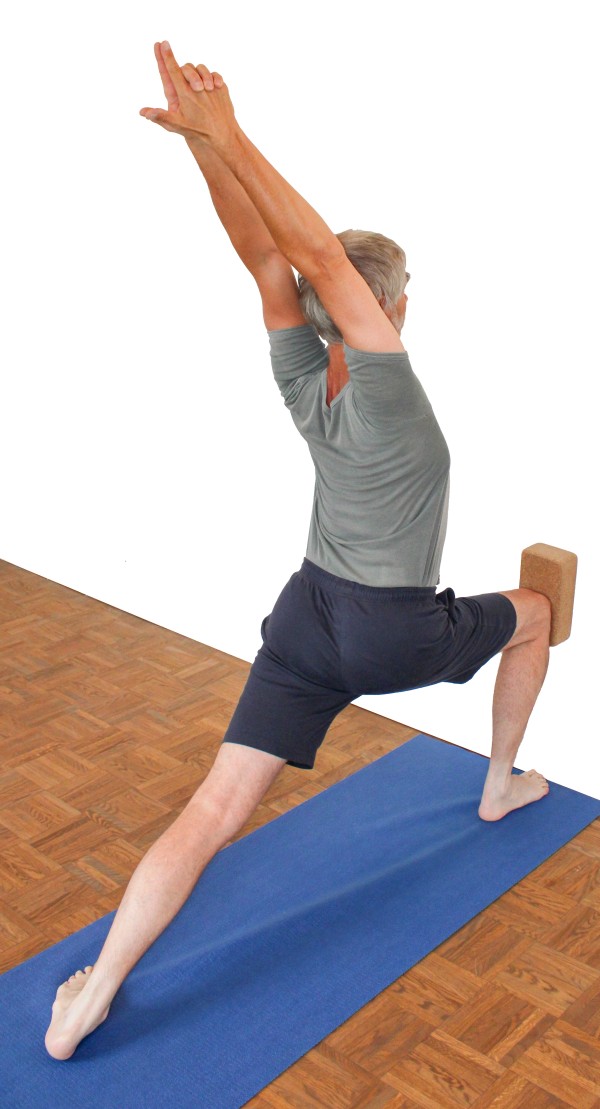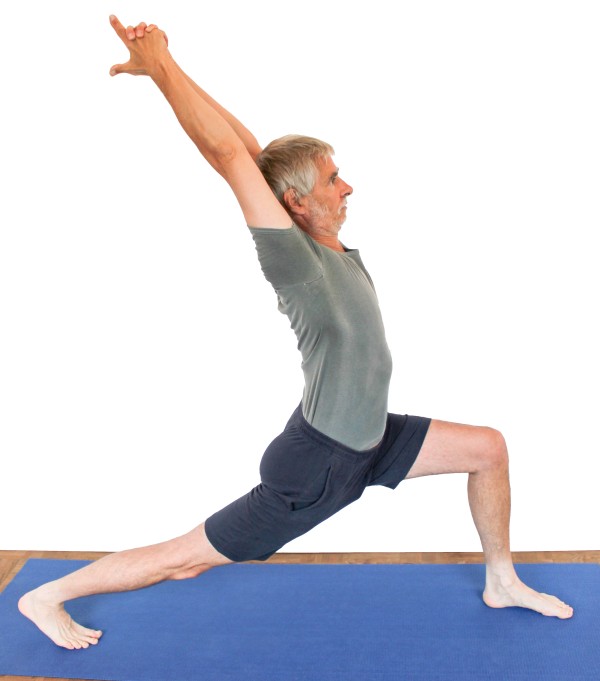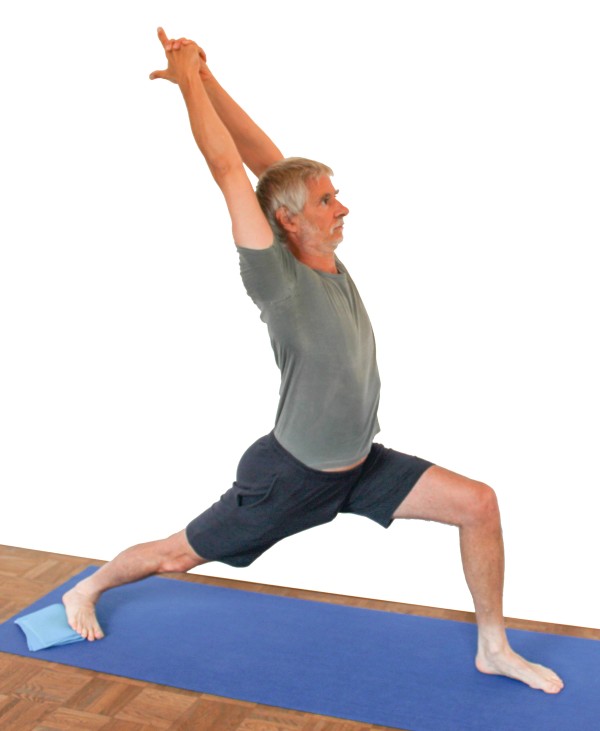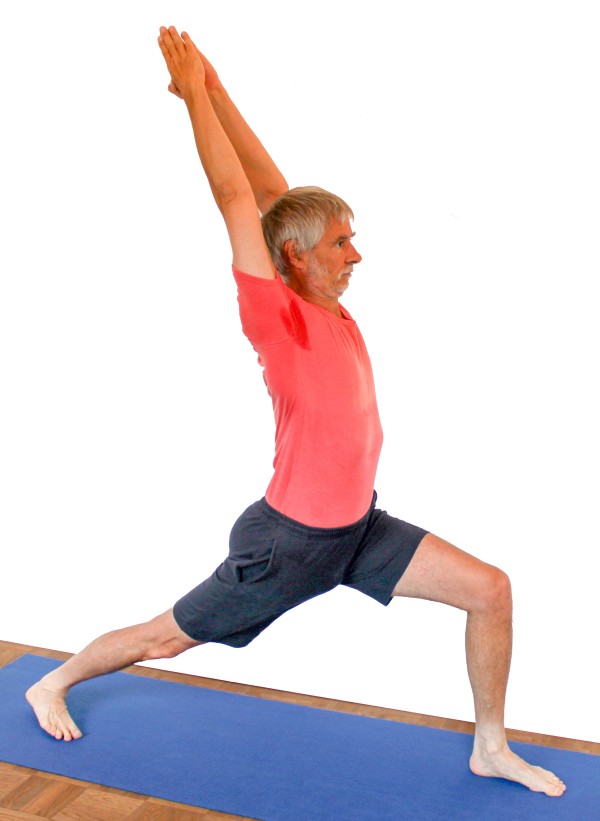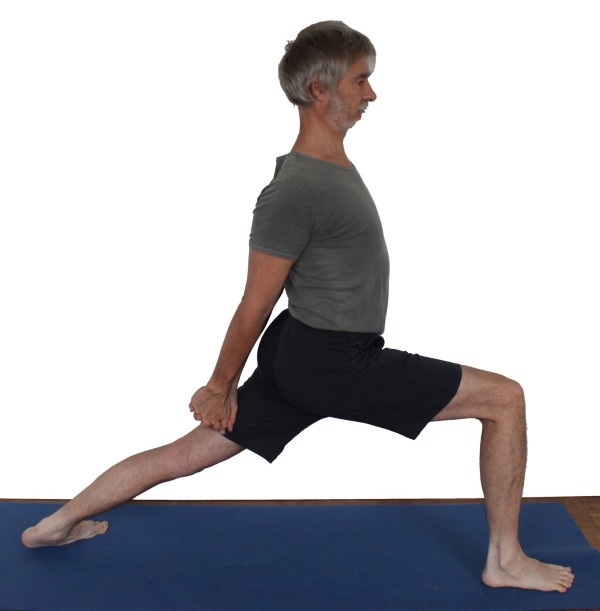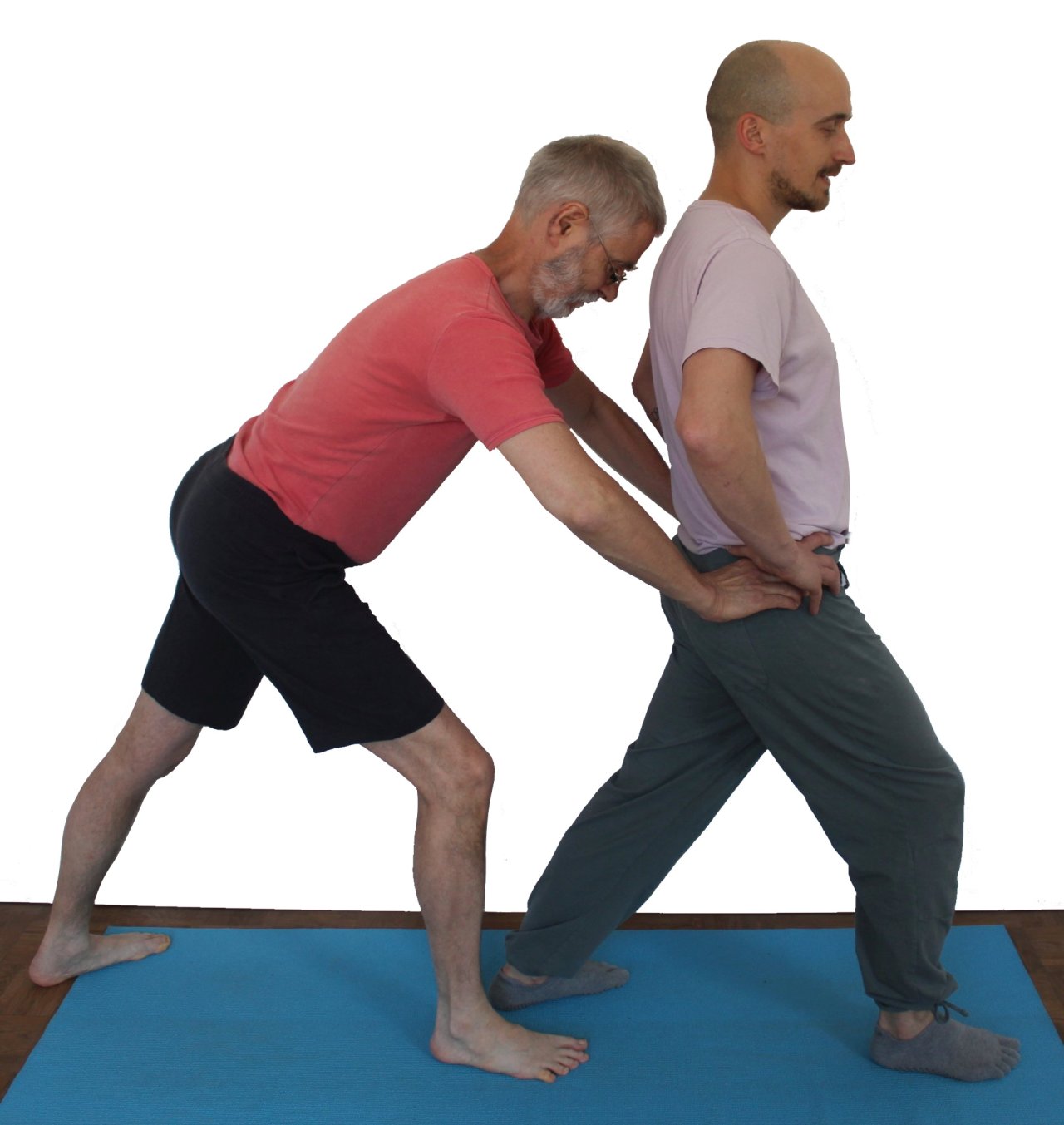- from a more than just a leg-wide straddle
turn in the left foot by 45 to 60° and turn the right foot out by 90°.
- turn the pelvis with the upper body 90° in the direction of the right leg,
whereby the "right" leg becomes the "front" leg and the "left" leg becomes the "rear"one.
- If the pelvis should have tilted forward and downward, the pelvis should be
raised back into the upright position with the force of the butt muscles.
Keep the position of the pelvis stable by the pressure of the legs.
Turn the left leg in to the maximum. Push the feet apart against the
resistance of the floor. Press the left heel to the ground and the right ball
of the foot (without making the heel too light) also. Both hips are and
are to remain equally high and equally turned to the front
- Bend the right knee in a controlled manner, whereby increasing bending also allows
increasing pressure of the feet away from each other
- turn the arms next to the body as far as possible, keeping the palms of your hands facing outwards.
Then bring your arms up over the outside and put your hands together above your head,
palms on top of each other, your thumbs crossed. Stretch your arms out
of the shoulder upwards (elevating the shoulder blades).
- If necessary, straighten the pelvis again with the force of the butt muscles and
bring the upper body and arms into a slight back bend.
- As long as the pelvis can be kept upright and turned forward, the front knee
can be bent further. If the knee should come forward beyond the heel,
the distance between the feet must be increased so that the knee stands
above the heel with maximum possible flexion (so that the pelvis can remain upright).
|
- By bending the right knee it is possible to use the quadriceps.
m.quadriceps for:
- pushing the feet apart (a kind of stretching movement
in the knee, which does not push the pelvis up,
because the ischiocrural group prevents this)
- pressing down the back heel
- pushing the pelvis into the correct position. The legs push
the corresponding hip in the right direction,
the back leg pushes the corresponding hip forwards and
the front leg pushes the corresponding hip backwards.
- the maintenance of the height of the pelvis as it is
pushed downwards by its own weight and that of the partial body weight above it
- the pelvis should be straight, i. e. the hip bones are turned evenly to the front.
This is important for:
- healthy pressure conditions in the
sacroiliac joint
- the condition of the (especially lower) back: the straighter
the pelvis, the less one-sided strain occurs in the back muscles
- the possibility of stretching the
m. iliopsoas (back leg) and the
m. rectus femoris (back leg).
- the possibility of stretching the calf and foot muscles
- the pelvis has to be erected as much as possible because of:
- also the possibility of stretching the
m. iliopsoas (back leg) and, clearly subordinate the
m.rectus femoris (back leg).
- the condition of the lower back (see above)
- enabling for an even upper body back bend. A person whose
lower back hurts will hardly want to lean back in the middle back
- the (especially one-sided: on the side of the bent leg) strengthening of the
m.glutaeus max.to be performed.
- turn in the rear leg (not the foot!) in the hip in the 30°-45° rotated
position of the leg, which helps to keep the corresponding hip forward
which helps to hold the corresponding hip in front,
i.e. to move the inner knee backwards in relation to the outer knee.
- Keep the right leg straight in the sense that the knee, heel and hip are
in a vertical plane. The front foot and the entire front leg stand in a
plane parallel to it, i. e. the knee does not tilt inwards or outwards
and the foot does not stand obliquely. It is ideal if the knee is
vertical above the heel and at the same time the thigh is horizontal.
- take your head only in the back of your neck, if this does not significantly
affect the stability of your pose.
- in hypertension, don't lift your arms nor take your head in your neck.
- only let the back heel come up if:
- you want to use the posture primarily for coarse strengthening of the legs or
- if otherwise the pelvis is not to be held straight or if
the front knee could not be bent when the pelvis is held straight.
Keep in mind that raising the rear heel significantly destabilises the pose, as the
base of support then is much smaller
- Prevent the swinging movement around the longitudinal axis of the front foot by using the calf muscles vigorously to force the ball of the foot fully and calmly onto the ground.
As in many other postures, where the safe standing in the pose clearly depends on the work of the front leg due to a narrow
support base , the moment you think you are standing safely and could therefore reduce the activity in the front lower leg a little, is the moment you start wiggling or even tipping over!
- the front foot points in its elongation to the back heel, in the case of
experienced persons possibly to the rear centre of the foot.
Both correspond to a varying degree of light adduction of the posterior leg.
- Stretch your arms out of your shoulders backwards and up. Turn out the
arms as far as possible. Hold the palms of your hands together and
cross your thumbs. Change with the side of the asana also the
entanglement of the thumbs.
- the angle of the rear foot to the front should be between 30° and 45°.
Note that everyone has an individual optimum. This is a compromise between
the restrictions on the flexibility of the foot and pelvis.
The following two rules of thumb apply:
´
- if the heel cannot come to the ground at an angle of 30° or
remains too light, an enlargement of the angle up to 45 degree is necessary
- if the hip, which belongs to the stretched rear leg is not able
to come forward sufficiently far or only if the front knee does not
bend fully (90°), a reduction of the angle down to minimum 30 degree is necessary.
If the pelvis cannot be turned forwards and the rear heel cannot be held on the floor at the same time,
the distance between the feet is too great.
If the front knee cannot be bent with the back leg turned 30°
and the pelvis upright without the pelvis swerving,
the hip flexors are too inflexible to fulfil all the conditions
at the same time and some compromises must be made which obey
the maxim "maximum effectiveness with ideally zero side effects"!
In fact, often both conditions 1) und 2) often apply at the same time, so practice one time with
the focus on wide bending of the front knee and a straight pelvis but
lifted heel and the other time with the heel on the floor and the
pelvis straight but insufficient bending of the front knee.
The first of the two options serves more to strengthen the front thigh and the back
m. rectus femoris and the muscles of the front lower leg, since the
base of support is much narrower and therefore the front foot has to carry out more
compensatory movements by the strength of the lower leg muscles,
the other one is more about improvement of the flexibility of the foot and the
hip flexors. It is therefore important to find the personal optimum by experimenting and to
observe over time whether and how it changes.
- the posterior leg should be stretched with force, not only in order to ensure the stretching of the
hip flexors but also to reduce the effect of occurring
torsion momentums in the knee joint.
Especially, if there is pain in the inner knee of the back leg, increase the use of force of the
quadriceps of the back leg and additionally turn in the back leg more vigurously.
Except in the case of pathologically altered knees, such pain almost always turns
out to be a consequence of the knee not having been
stretched thouroughly or the leg not having been turned out enough
- Note: if the pose is taken from a straddle by turning in one leg 45° to 60° and
turning out the other leg 90°, at the beginning of the process when the first
leg is turned in 45-60°, this leg is in a strong endorotation that lies at the
edge of the range of movement or even beyond it, so the pelvis is forced to
evade (in the sense of rotation in the plane). After the second leg has been
turned out 90° and the pelvis turned 90° in the same direction, the second
leg is therefore in 0° rotation, but the first leg is no longer in endorotation
but 30° exorotation! When the pelvis is turned, the posterior leg changes from
endorotation to exorotation. Nevertheless, the movement that this leg has to
make in the pose is as strong an endorotation as possible.
| known issues that may occur even when practicing correctly |
|
|


